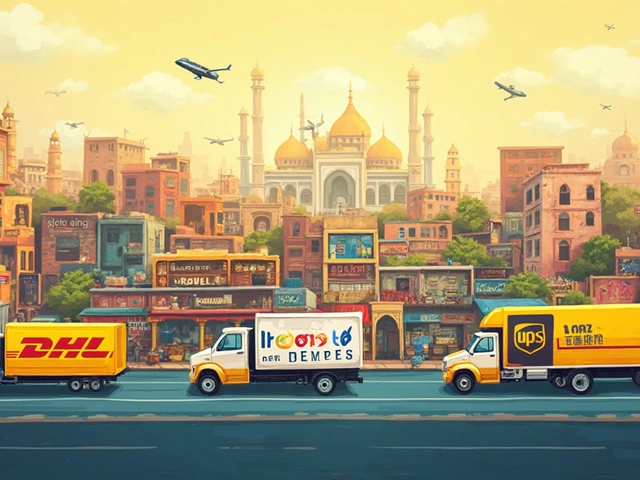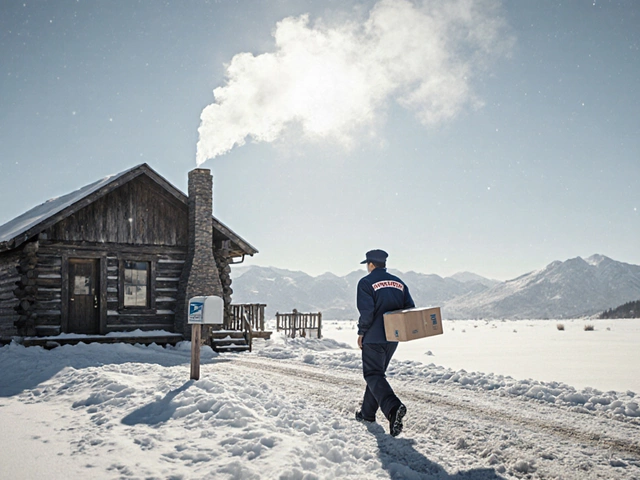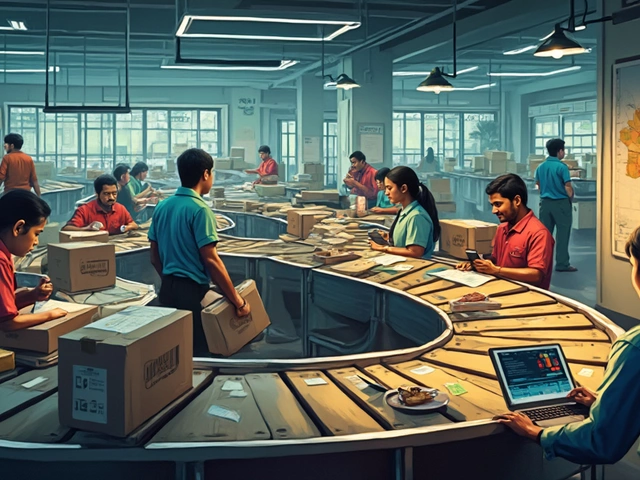The brown UPS truck rolling down your street isn’t just running on fuel and caffeine. Behind every delivery, there’s a crazy-smart web of software making sure packages land on your doorstep right when you expect them—or sometimes even faster.
UPS doesn’t just use one piece of software; it runs on a cluster of specialized systems that talk to each other all day. Their big star is ORION (that’s On-Road Integrated Optimization and Navigation), a system that uses real-time data to plan the most efficient routes for drivers. This isn’t just about GPS—ORION re-plans delivery routes on the fly, adjusting for traffic, weather, and last-minute pick-ups. The result? UPS claims it saves them about 10 million gallons of fuel every year and slices off millions of miles from their routes.
But the tracking magic doesn’t stop with the route. From the moment a package enters the UPS network, it’s logged and tracked through their proprietary tracking system, which feeds info not just to internal teams but also to customers who want their stuff ASAP. If you’re running a business and want to sharpen your own delivery game, there’s a lot to learn from how UPS mixes route planning, live tracking, and tight supply chain integration—all backed by software that actually talks together.
- The Backbone: ORION and More
- How UPS Tracks Packages at Scale
- Beyond Delivery: Warehouse and Fleet Management
- Integration with Partners and Customers
- Lessons for Your Own Logistics
The Backbone: ORION and More
Let’s get straight to UPS’s secret weapon: ORION (On-Road Integrated Optimization and Navigation). This isn’t just a map tool with bells and whistles—it’s one of the smartest logistics software systems in the business. ORION works by collecting and crunching data from over 250 million map points, driver input, traffic reports, and package statuses so it can spit out the most efficient route for every single UPS package car. Seriously, every driver gets a route that’s custom-fit to that day’s needs, and ORION can tweak that route on the fly if there’s a traffic jam or another hiccup.
UPS started rolling out ORION around 2013, and since then, it’s racked up some eye-popping numbers. The company estimates that ORION helps trim 100 million miles off their travel each year and saves them $400 million annually just in fuel, maintenance, and time. Need some hard numbers?
| Year | Miles Saved (Millions) | Fuel Saved (Gallons, Millions) | Estimated Savings ($ Millions) |
|---|---|---|---|
| 2020 | 100 | 10 | 400 |
But ORION doesn’t act alone. UPS leans on a combo of other proprietary systems as well. There’s the Package Flow Technology, which connects what happens in warehouses to what happens on the road—think of it as the backstage crew for the logistics show. Another important piece is NAVIOS, which helps manage international container shipments and customs data, making sure global deliveries don’t get stuck in red tape.
If you’re in logistics IT or just want to up your own game, here’s a key takeaway: UPS integrates all this tech so data moves with the package, not just behind the scenes. Route planners, drivers, and warehouse teams stay on the same page with live updates. If you want your team working smarter, building that kind of real-time visibility into your supply chain is a must. That’s a big reason why UPS logistics software is a global benchmark.
How UPS Tracks Packages at Scale
If you’ve ever tracked a UPS package online and watched it move city by city, stop by stop—yeah, the tech behind that is wild. UPS tracking system is like the control center of a spaceship, only for millions of brown boxes spread across the globe.
Every package gets hit with a barcode the second it enters a UPS facility. These barcodes are the key to the whole thing. At each step—from the sorting hub to the delivery truck—scanners zap the code, instantly updating the package’s status in the UPS logistics software. These updates feed straight into the main tracking database, so both the customer and the driver always know what’s where.
All this real-time data isn’t just for show. It helps UPS reroute packages when something unexpected happens—think weather, road closures, or the rare, dreaded mis-sort. There’s a ginormous network of sensors and handheld devices, all linked via a secure, cloud-based system. The actual data flows through UPS’s Package Flow Technology (PFT), which sorts, sequences, and even schedules when and where to load boxes in each truck.
Wanna know how much data we’re talking about? Look at this:
| Daily Packages Tracked | Active Trackers Used | UPS Data Updates Per Day |
|---|---|---|
| Over 37 million | More than 500,000 | Billions |
UPS’s Senior VP Dave Barnes said it best:
“Tracking a single package isn’t hard. Tracking millions, rerouting in real time, and making it all visible to customers—that’s where software gives us a huge edge.”
If you’re in business, here’s a tip: borrowing this kind of package visibility (even on a much smaller scale) can make a world of difference. You don’t need to be a global giant—there are entry-level tracking platforms out there that borrow the same real-time barcode scans and cloud syncing that UPS logistics software perfected. Customers expect to know where their stuff is every step of the way, no matter the company size.

Beyond Delivery: Warehouse and Fleet Management
When most folks think about UPS logistics software, they picture package tracking and routes, but keeping warehouses humming and the fleet in top shape is just as critical. UPS leans on its in-house global operations platform (GOP) to keep inventory moving, manage sorting facilities, and maintain their massive fleet. This means everything from making sure the right boxes are on the right truck, to scheduling maintenance for 120,000+ vehicles, is tracked and optimized by software.
One of the heavy hitters here is the UPS Transportation Management System (TMS). This tool lines up shipments, designs load plans for trucks and aircraft, and even helps decide when to swap out delivery vans in the lineup. TMS keeps things flexible—so if one warehouse suddenly gets slammed with orders, the system can quickly re-route trucks and shift warehouse resources to balance the pressure.
- Smart Scanning: Every package passing through a UPS warehouse gets scanned using handheld devices that instantly upload its location into the network. With all that data, warehouse teams can pinpoint where anything is—no more hunting for lost boxes.
- Automated Sorting: Some UPS hubs use advanced robotics and conveyor systems to sort parcels at blazing speeds. In their Louisville hub alone, they process about 416,000 packages per hour during peak season!
- Fleet Monitoring: UPS connects every truck with telematics devices—that means sensors checking engine health, driver speed, and even idling time. Managers can spot issues fast and keep trucks rolling, while software flags vans needing oil changes, tires, or battery swaps.
UPS’s scale means they don’t skip on tech. In fact, they rolled out a tool called Network Planning Tools (NPT) a few years back to simulate and adjust their whole network in real-time. A senior UPS exec explained it in simple terms:
“With NPT, we can adjust our network on the fly—reroute trucks, rebalance warehouses, and keep customer promises, even when curveballs come our way.”
If you run a business with a warehouse or a few delivery trucks, here are some lessons from how UPS does it:
- Automate inventory scans and tracking—don’t rely on manual logs.
- Monitor your vehicles with telematics. Even basic devices can save a ton on unexpected breakdowns.
- Think about investing in software that supports dynamic route and resource planning, especially during busy times.
UPS’s approach to logistics IT and fleet management might look huge, but the principles scale down for any business. Keep everything connected, keep everything visible, and let the software do what it does best—make logistics smooth.
Integration with Partners and Customers
UPS doesn’t build walls around its tech. Instead, their logistics software is all about playing well with others—whether that’s a mom-and-pop ecommerce store or a monster retail chain. At the heart of this is their ability to connect their ORION routing engine and advanced UPS tracking system to business partners’ own systems, making it pretty much plug-and-play for most modern platforms.
For big businesses, UPS offers direct API access. That means if you're running an online store or warehouse, you can have orders automatically sent to UPS, print shipping labels with the same barcodes UPS uses, and even display package tracking info to customers in real time. Their APIs cover everything from shipment creation to real-time UPS tracking system updates—so your customers can see their package move from warehouse to doorstep without leaving your site.
Small businesses aren’t left out either. UPS tools like WorldShip or UPS CampusShip let folks with no IT department handle shipments, schedule pickups, and track deliveries all in a browser. You get many of the same perks the giants do, just packaged in a simple dashboard.
- Electronic Data Interchange (EDI): Large retailers and suppliers are plugged in through EDI, so order and delivery data fly back and forth automatically. Less time on paperwork, more time getting boxes out the door.
- Custom Integrations: UPS works directly with partners like Shopify and Amazon for tighter logistics, even supporting things like two-day delivery guarantees.
- My Choice® and Customer Tools: Customers can reroute, hold, or reschedule packages online thanks to seamless back-and-forth between the UPS tracking platform and these front-end tools.
Check out these stats—by connecting over 200,000 business partners through integrated APIs, UPS has made tracking and delivery way smoother.
| Integration Type | Key Benefit |
|---|---|
| API | Instant order, label, and tracking management |
| EDI | Hands-free data transfer for big operations |
| WorldShip/CampusShip | User-friendly for small to mid-size businesses |
The takeaway? Whether you’re a huge warehouse or just shipping a few boxes, UPS has built its logistics IT so you can hook right in, keep your customers updated, and keep things simple on your end.

Lessons for Your Own Logistics
Studying how UPS runs things is like getting a blueprint for better deliveries, no matter how big or small your business is. You might not have a billion-dollar tech budget, but there’s no reason you can’t borrow some of their playbook.
First, take route optimization. UPS’s ORION is famous for shaving off unnecessary miles and minutes. You don’t need custom algorithms to get started—begin with plug-and-play logistics software that offers real-time route updates, like Routific or Onfleet. Even Google Maps can do wonders for small gig teams. Getting your drivers the fastest delivery order adds up in saved fuel and happier customers.
Next, look at package tracking. UPS scans every single parcel multiple times on its journey. That’s a huge reason people trust them—they know where their stuff is. Even small businesses can do this using barcode tracking or affordable GPS software. Giving your customers regular status updates will cut down on those “where’s my package?” emails and calls, plus it makes your brand look sharp.
Don’t forget about warehouse management. UPS uses tons of sensors and scans to keep their supply chain on track. You can start lighter: organize your shelves, adopt simple inventory apps like Sortly or Zoho Inventory, and set up regular cycle counts to avoid out-of-stock headaches.
Also, connect your systems. UPS wins because their logistics software all talks together, from package sorting to fleet tracking. Use tools that work with your eCommerce platform, order management, and accounting—no more double entry or lost orders. Zapier, Shopify plugins, or QuickBooks integrations can really speed things up and keep errors out.
Check out these quick-hit takeaways inspired by UPS:
- Use route planning tools, even if it’s just Google Maps for now
- Scan and track every outgoing order
- Keep your warehouse neat, and try low-cost inventory software
- Automate status updates to customers—it builds trust fast
- Pick tools that integrate, so your data doesn’t get stuck in silos
According to a study by the Council of Supply Chain Management Professionals, businesses that use basic logistics software see up to 15% faster delivery times and 10% cost reductions compared to those that don’t. That shows you don’t have to be UPS to get real value from a few smart changes.
| Method | Potential Benefit |
|---|---|
| Route Optimization | Save fuel, faster delivery |
| Package Tracking | Fewer lost items, happier customers |
| Inventory Management | Less stockout, smoother operations |
| System Integration | Fewer errors, less admin time |
Try just one or two of these upgrades, and you’ll probably notice a difference by next month. Copy what works, skip the hype, and make your deliveries work like the big guys.





